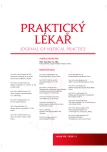Sit-to-stand test in fall prediction in elderly adults: what are the options of use in clinical practice?
Authors:
Z. Kováčiková 1; K. Neumannová 2; J. Sarvestan 1; E. Zemková 3; M. Janura 1
Authors‘ workplace:
Univerzita Palackého, Olomouc, Fakulta tělesné kultury
; Katedra přírodních věd v kinantropologii, Vedoucí: prof. RNDr. Miroslav Janura, Dr.
1; Katedra fyzioterapie, FTK UP, Olomouc, Vedoucí: PhDr. David Smékal, Ph. D.
2; Univerzita Komenského, Bratislava, Fakulta telesnej výchovy a športu, Katedra biologických a lekárskych vied, Vedúci: Mgr. Gabriel Buzgó, PhD.
3
Published in:
Prakt. Lék. 2020; 100(2): 78-82
Category:
Of different specialties
Overview
Less or more serious injuries, prolonged convalescence, functional limitations and physical inactivity are the most frequent consequences of falls in elderly adults. Although there is a high prevalence of falls in this population, the risk of falling is not routinely diagnosed in clinical practice in this population in time. In this study, we focused on elderly adults over 60 years of age who did not have any acute or chronic disease. The study aimed to assess the risk of fall occurrence with an easy administered clinical test – Five-repetition sit-to-stand test. The results revealed that more than half of our subjects achieved a longer time in the test compared to the average performance of the population of the same age. Of this, 26% of elderly adults aged 70–79 years and 50% of elderly adults aged 80–89 years achieved time longer than 15 s (18,1 ± 2,9 s and 16,3 ± 1,1 s, respectively), which is a critical value for increased risk of recurrent falls in people aged over 65 years. This test can help to predict fall risk not only in the elderly adults who can be expected to falls due to disease but also in those who are not treated for any acute or chronic disease, as in our study
Keywords:
muscle strength – clinical test – Five-repetition sit-to-stand test – balance – balance training
Sources
1. Baltich J, von Tscharner V, Nigg BM. Degradation of postural control with aging. Proc Inst Mech Eng H 2015; 229(9): 638–644.
2. Bohannon RW. Reference values for the five-repetition sit-to-stand test: a descriptive meta-analysis of data from elders. Percept Mot Ski 2006; 103(1): 215–222.
3. Bohannon RW. Daily sit-to-stands performed by adults: a systematic review. J Phys Ther Sci 2015; 27(3): 939–942.
4. Brabcová I, Hajduchová H, Tóthová V, Bártlová S. Souvislosti mezi pády pacientů a vybranými rizikovými faktory. Prakt. Lék. 2017; 97(4): 163–167.
5. Buatois S, Miljkovic D, Manckoundia P, et al. Five times sit to stand test is a predictor of recurrent falls in healthy community – living subjects aged 65 and older. J Am Geriatr Soc 2008; 56(8): 1575–1577.
6. de Almeida Lourenço M, Carli FVBO, de Assis MR. Characterization of falls in adults with established rheumatoid arthritis and associated factors. Adv Rheumatol 2018; 58(1): 16.
7. Institute for Health Metrics and Evaluation (IHME). GBD Compare Data Visualization, 2016 [online]. Dostupné z: http://vizhub.healthdata.org/gbd-compare [cit. 2019-11-23].
8. Janda V, Vávrová M. Senzomotorická stimulace. Základy metodiky proprioceptivního cvičení. Rehabilitácia 1992; 3 : 14–34.
9. Najafi B, Aminian K, Loew F, et al. Measurement of stand-sit and sit-stand transitions using a miniature gyroscope and its application in fall risk evaluation in the elderly. IEEE T Bio-med Eng 2002; 49(8): 843–851.
10. Orr R. Contribution of muscle weakness to postural instability in the elderly. Eur J Phys Rehab Med 2010; 46(2): 183–220.
11. Petersen C, Steffen T, Paly E, et al. Reliability and minimal detectable change for sit-to-stand tests and the functional gait assessment for individuals with Parkinson disease. J Geriatr Phys Ther 2017; 40(4): 223–226.
12. Roig M, Eng JJ, Road JD, Reid WD. Falls in patients with chronic obstructive pulmonary disease: a call for further research. Respir Med 2009; 103(9): 1257–1269.
13. Rubenstein LZ. Falls in older people: epidemiology, risk factors and strategies for prevention. Age Ageing 2006; 35(Suppl 2): ii37–ii41.
14. Rubenstein LZ, Josephson KR, Robbins AS. Falls in the nursing home. Ann Intern Med 1994; 121(6): 442–451.
15. UK Department of Health & Social Care. Physical activity guidelines: UK Chief Medical Officers’ report [online]. Dostupné z: https://www.gov.uk/government/publications/physical-activity-guidelines-uk-chief-medical-officers-report [cit. 2019-11-04].
16. World Health Organization. Global recommendations on physical activity for health. Geneva: WHO 2010.
17. Yokoya T, Demura S, Sato S. Relationships between physical activity, ADL capability and fall risk in community-dwelling Japanese elderly population. Environ Health Prev Med 2007; 12(1), 25–32.
18. Zeleníková R, Kozáková R, Jarošová D. Intervence v prevenci pádů seniorů v institucích: přehledová studie. Prakt. Lék. 2015; 95(1): 20–30.
Labels
General practitioner for children and adolescents General practitioner for adultsArticle was published in
General Practitioner

2020 Issue 2
Most read in this issue
- General overview of percutaneous endoscopic gastrostomy
- Anxiety of pregnant women – importance, risk factors, consequences
- Standard, neglected and new information about compression therapy with bandages
- Thyroid cancers
